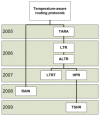A survey on temperature-aware routing protocols in wireless body sensor networks
- PMID: 23917259
- PMCID: PMC3812583
- DOI: 10.3390/s130809860
A survey on temperature-aware routing protocols in wireless body sensor networks
Abstract
The rapid growth of the elderly population in the world and the rising cost of healthcare impose big issues for healthcare and medical monitoring. A Wireless Body Sensor Network (WBSN) is comprised of small sensor nodes attached inside, on or around a human body, the main purpose of which is to monitor the functions and surroundings of the human body. However, the heat generated by the node's circuitry and antenna could cause damage to the human tissue. Therefore, in designing a routing protocol for WBSNs, it is important to reduce the heat by incorporating temperature into the routing metric. The main contribution of this paper is to survey existing temperature-aware routing protocols that have been proposed for WBSNs. In this paper, we present a brief overview of WBSNs, review the existing routing protocols comparatively and discuss challenging open issues in the design of routing protocols.
Figures






Similar articles
-
QoS and energy aware cooperative routing protocol for wildfire monitoring wireless sensor networks.ScientificWorldJournal. 2013 Jun 13;2013:437926. doi: 10.1155/2013/437926. Print 2013. ScientificWorldJournal. 2013. PMID: 23843735 Free PMC article.
-
On the MAC/network/energy performance evaluation of Wireless Sensor Networks: Contrasting MPH, AODV, DSR and ZTR routing protocols.Sensors (Basel). 2014 Dec 2;14(12):22811-47. doi: 10.3390/s141222811. Sensors (Basel). 2014. PMID: 25474377 Free PMC article.
-
An energy-aware routing protocol for query-based applications in wireless sensor networks.ScientificWorldJournal. 2014 Feb 13;2014:359897. doi: 10.1155/2014/359897. eCollection 2014. ScientificWorldJournal. 2014. PMID: 24696640 Free PMC article.
-
A comparative study of wireless sensor networks and their routing protocols.Sensors (Basel). 2010;10(12):10506-23. doi: 10.3390/s101210506. Epub 2010 Nov 24. Sensors (Basel). 2010. PMID: 22163483 Free PMC article. Review.
-
[Advances in sensor node and wireless communication technology of body sensor network].Sheng Wu Yi Xue Gong Cheng Xue Za Zhi. 2012 Jun;29(3):568-73. Sheng Wu Yi Xue Gong Cheng Xue Za Zhi. 2012. PMID: 22826960 Review. Chinese.
Cited by
-
Data-Centric Routing for Intra Wireless Body Sensor Networks.J Med Syst. 2015 Sep;39(9):91. doi: 10.1007/s10916-015-0268-5. Epub 2015 Aug 5. J Med Syst. 2015. PMID: 26242749
-
TAEO-A Thermal Aware & Energy Optimized Routing Protocol for Wireless Body Area Networks.Sensors (Basel). 2019 Jul 25;19(15):3275. doi: 10.3390/s19153275. Sensors (Basel). 2019. PMID: 31349623 Free PMC article.
-
Human Activity Recognition: A Dynamic Inductive Bias Selection Perspective.Sensors (Basel). 2021 Nov 1;21(21):7278. doi: 10.3390/s21217278. Sensors (Basel). 2021. PMID: 34770583 Free PMC article.
-
A survey of routing protocols in wireless body sensor networks.Sensors (Basel). 2014 Jan 13;14(1):1322-57. doi: 10.3390/s140101322. Sensors (Basel). 2014. PMID: 24419163 Free PMC article.
-
A comprehensive survey of energy-aware routing protocols in wireless body area sensor networks.J Med Syst. 2016 Sep;40(9):201. doi: 10.1007/s10916-016-0556-8. Epub 2016 Jul 28. J Med Syst. 2016. PMID: 27468842
References
-
- United Nations World Population Prospects: The 2010 Revision. [(accessed on 5 March 2012)]. Available online: http://esa.un.org/wpp/
-
- IEEE Standard for Local and Metropolitan Area Networks-Part 15.6: Wireless Body Area Networks. 2012 Feb 29;:1–271. IEEE Std 802.15.6-2012.
-
- Ullah S., Higgins H., Braem B., Latre B., Blondia C., Moerman I., Saleem S., Rahman Z., Kwak K.S. A comprehensive survey of wireless body area networks. J. Med. Syst. 2012;36:1065–1094. - PubMed
-
- Hirata A., Shiozawa T. Correlation of maximum temperature increase and peak SAR in the human head due to handset antennas. IEEE T. Microw. Theory. 2003;51:1834–1841.
-
- Havenith G. Individualized model of human thremoregulation for the simulation of heat stress response. J. Appl. Physiol. 2001;90:1943–1954. - PubMed
Publication types
MeSH terms
LinkOut - more resources
Full Text Sources
Other Literature Sources

